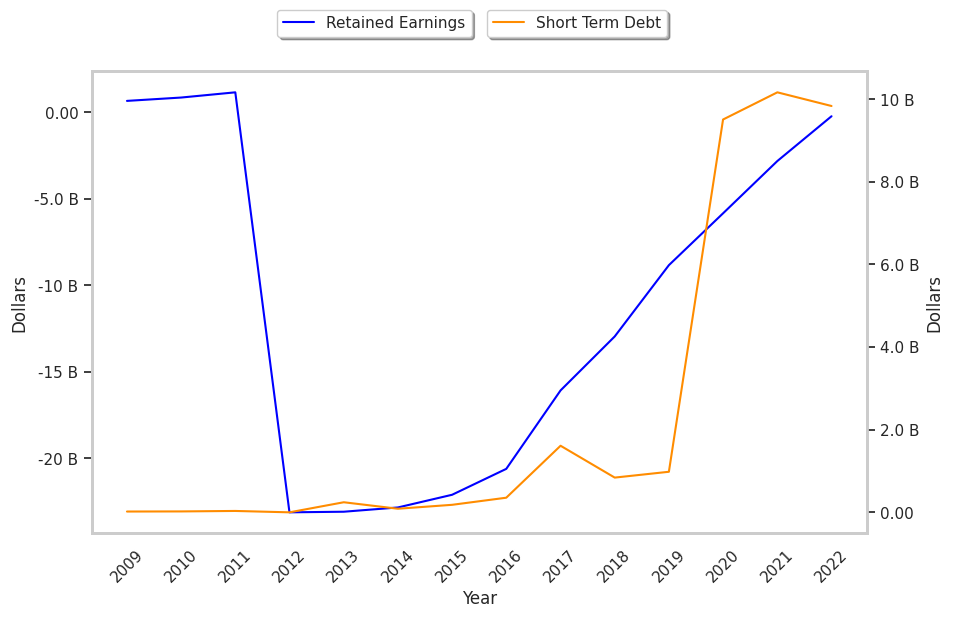Shares of T-Mobile US (TMUS) jumped 0.7 % during today's morning session, bringing their 52 week performance to 8.0%. The stock seems to be overvalued in terms of traditional metrics, but in this day in age, we believe that a complete stock analysis should also take into account the company's poor growth indicators and positive market sentiment.
T-Mobile US, Inc., together with its subsidiaries, provides mobile communications services in the United States, Puerto Rico, and the United States Virgin Islands. The large-cap Telecommunications company is based in Bellevue, United States and has 71,000 full time employees.
TMUS Has a Higher P/E Ratio Than the Sector Average
Compared to the Telecommunications sector's average of 18.85, T-Mobile US has a trailing twelve month price to earnings (P/E) ratio of 28.7 and an expected P/E ratio of 14.4. The P/E ratios are calculated by dividing the company's share price by its trailing 12 month of $4.95 or forward earnings per share of $9.88.
Earnings represent the net profits left over after subtracting costs of goods sold, taxes, and operating costs from the company's recorded sales revenue. One way of looking at the P/E ratio is that it represents how much investors are willing to pay for every dollar's worth of the company's earnings. Since T-Mobile US's P/E ratio is higher than its sector average of 18.85, we can deduce that the market is overvaluing the company's earnings.
T-Mobile US Is Fairly Valued in Terms of Expected Growth
Another factor pointing to T-Mobile US's value is its PEG ratio of 0.29. This is the stock's price to earnings ratio divided by its estimated earnings growth rate. If the resulting ratio is near or lower than 1 -- but higher than 0 -- its indicates that the company is faitly valued in terms of expected growth.
TMUS Has an Average P/B Ratio
Traditionally, stock pickers used to focus primarily on finding issues that were trading significantly below their tangible asset value, to guarantee themselves a margin of safety. But such an approach would screen out many valuable securities because many profitable businesses -- especially those that heavily leverage information technology -- simply do not have many tangible assets compared to more capital intensive companies.
Therefore, modern value investors tend to focus less on absolute price to book value (P/B) ratios. Instead of singling out stocks with a P/B ratio of less than 1, they will compare the target company against its peer group. For T-Mobile US, the P/B value is 2.55 while the average for the Telecommunications sector is 3.12.
TMUS's Weak Cash Flow Generation Is Troubling
The table below shows that T-Mobile US is not generating enough cash. A well run company will generally have cash flows that reflect the strength of its underlying business, and in T-Mobile US's case, free cash flow is growing at an average rate of 0.0% with a coefficient of variability of 52118890108.8%. We can also see that cash flows from operations are evolving at a 0.0% rate, versus 0.0%:
| Date Reported | Cash Flow from Operations ($ k) | Capital expenditures ($ k) | Free Cash Flow ($ k) | YoY Growth (%) |
|---|---|---|---|---|
| 2023-02-14 | 16,781,000 | -17,301,000 | 34,082,000 | -4.29 |
| 2022-02-11 | 13,917,000 | -21,692,000 | 35,609,000 | 69.51 |
| 2021-02-23 | 8,640,000 | -12,367,000 | 21,007,000 | 48.12 |
| 2020-02-06 | 6,824,000 | -7,358,000 | 14,182,000 | 48.24 |
| 2019-02-07 | 3,899,000 | -5,668,000 | 9,567,000 | -35.77 |
| 2018-02-08 | 3,831,000 | -11,065,000 | 14,896,000 |
T-Mobile US's Is a Profitable Business
If you are looking to make TMUS a long term investment, it's essential that you understand the viability of its business through a study of its margins. Gross margins tell you how much the company makes in profit when only the costs directly related to producing the goods or delivering the service are taken into account. Operating margins, on the other hand, factor in overhead costs so they tell you how effectively T-Mobile US is run.
T-Mobile US's Gross Margins
| Date Reported | Revenue ($ k) | Cost of Revenue ($ k) | Gross Margins (%) | YoY Growth (%) |
|---|---|---|---|---|
| 2023-02-14 | 79,571,000 | -36,206,000 | 54 | 0.0 |
| 2022-02-11 | 80,118,000 | -36,605,000 | 54 | -8.47 |
| 2021-02-23 | 68,397,000 | -28,266,000 | 59 | 0.0 |
| 2020-02-06 | 44,998,000 | -18,521,000 | 59 | 3.51 |
| 2019-02-07 | 43,310,000 | -18,354,000 | 57 | 1.79 |
| 2018-02-08 | 40,604,000 | -17,708,000 | 56 |
T-Mobile US's Operating Margins
| Date Reported | Total Revenue ($ k) | Operating Expenses ($ k) | Operating Margins (%) | YoY Growth (%) |
|---|---|---|---|---|
| 2023-02-14 | 79,571,000 | -35,258,000 | 10 | 11.11 |
| 2022-02-11 | 80,118,000 | -36,621,000 | 9 | -10.0 |
| 2021-02-23 | 68,397,000 | -33,077,000 | 10 | -23.08 |
| 2020-02-06 | 44,998,000 | -20,755,000 | 13 | 8.33 |
| 2019-02-07 | 43,310,000 | -19,647,000 | 12 | 9.09 |
| 2018-02-08 | 40,604,000 | -18,243,000 | 11 |
T-Mobile US's cost of revenue is growing at a rate of -0.0% in contrast to -21.3% for operating expenses. Sales revenues, on the other hand, have experienced a 0.0% growth rate. As a result, the average gross margins growth is 0.2 and the average operating margins growth rate is -1.3, with coefficients of variability of 4.0% and 13.6% respectively.
T-Mobile US Benefits From Positive Market Signals
The market sentiment regarding T-Mobile US is overwhelmingly positive. The stock has an average rating of buy and target prices ranging from $225.0 to $118.49. TMUS is trading -19.85% away from its target price of $177.33. 4.6% of the company's shares are tied to short positions, and 43.2% of the shares are held by institutional investors.
| Date Reported | Holder | Percentage | Shares | Value |
|---|---|---|---|---|
| 2023-06-30 | Vanguard Group Inc | 4% | 48,207,302 | $6,851,944,604 |
| 2023-06-30 | Softbank Group Corporation | 4% | 43,338,209 | $6,159,876,098 |
| 2023-06-30 | Blackrock Inc. | 3% | 39,469,060 | $5,609,934,626 |
| 2023-06-30 | Price (T.Rowe) Associates Inc | 3% | 37,195,382 | $5,286,765,416 |
| 2023-06-30 | State Street Corporation | 2% | 24,733,273 | $3,515,463,621 |
| 2022-12-31 | Norges Bank Investment Management | 2% | 20,010,302 | $2,844,164,164 |
| 2023-06-30 | FMR, LLC | 2% | 18,936,963 | $2,691,605,131 |
| 2023-06-30 | Geode Capital Management, LLC | 1% | 12,070,277 | $1,715,608,755 |
| 2023-06-30 | Dodge & Cox Inc | 1% | 11,506,948 | $1,635,539,990 |
| 2023-06-30 | Morgan Stanley | 1% | 11,151,000 | $1,584,947,323 |



